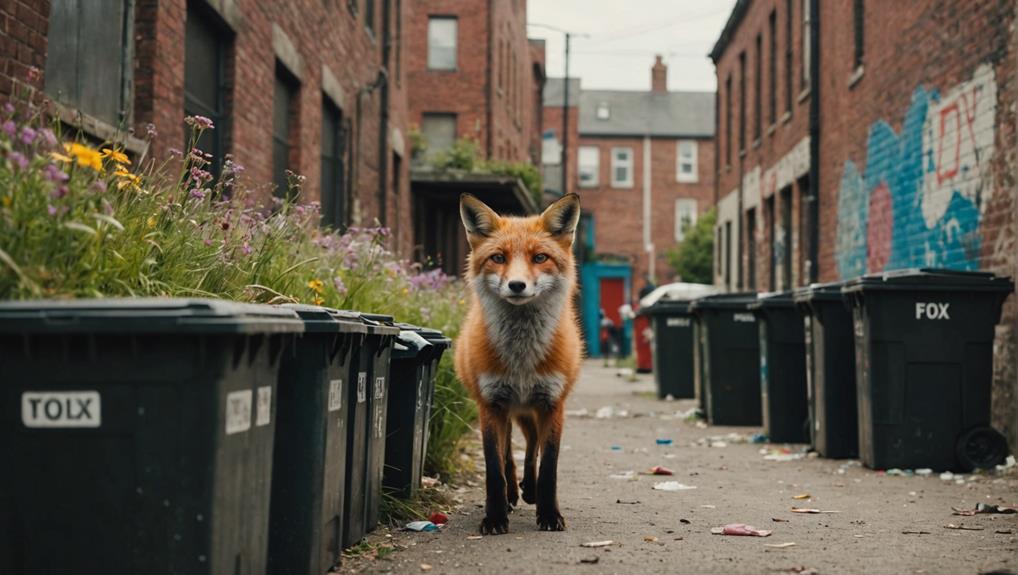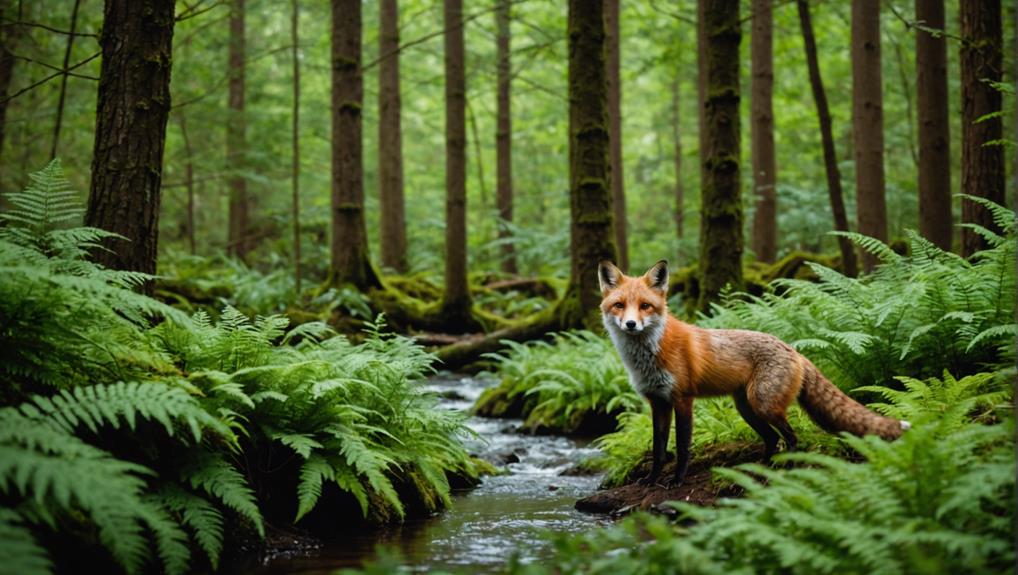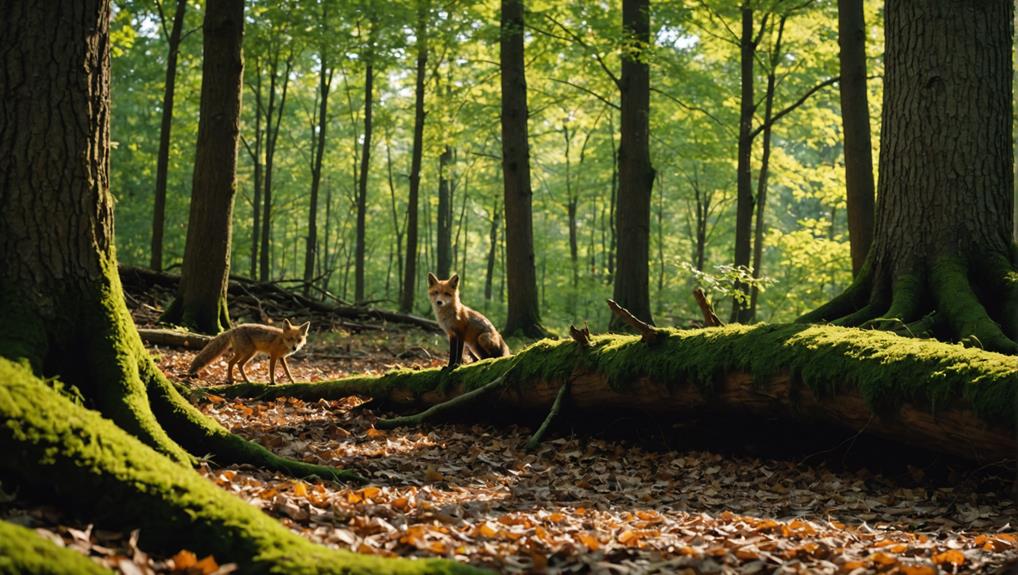Curious about red fox habitats? These clever critters love to hang out in forests, prairies, and even bustling cities! Males can claim up to 730 acres as their turf, while the ladies enjoy a cozier spot nearby. They're versatile animals, adjusting their habits seasonally—like honing in on prey with their sharp hearing in winter. Living in urban areas, they might scavenge human leftovers instead of hunting. But with climate change shaking things up, their territories are expanding, leading to a wild competition. Stick around, and you'll uncover more fascinating tidbits about these amazing animals and their secret lives!
Contents
Red Fox Habitats Across Continents
Red foxes, with their striking adaptability, thrive in a variety of habitats across continents. You'll find these clever creatures in places as diverse as marshes, prairies, tundra, and forests, particularly in the Northern Hemisphere.
They've got a knack for fitting in, whether in the wild expanses of Alaska or the bustling corners of urban life.
Their home range averages about 730 acres, giving them plenty of space to roam. Males tend to cover larger territories than females, but both are adaptable enough to make the most of their surroundings.
Preferred denning locations usually have good vegetation cover, offering safety and resources for raising their young.
As climate change reshapes the landscape, red foxes are expanding their population distribution, moving into new areas that were once too harsh. It's a testament to their resilience!
Diverse Ecosystems and Adaptation
As ecosystems vary widely across the globe, so too do the adaptations of the red fox, showcasing its remarkable versatility.
These clever creatures thrive in diverse ecosystems, from marshes to tundra and forests, demonstrating their incredible adaptability. In northern North America, especially in Alaska, red foxes are right at home, and their range is actually expanding southward thanks to climate change.
With an average home range of around 730 acres, red foxes exhibit territorial behaviors that help them efficiently navigate their habitats. They're clever at finding resources, whether in the wild or urban settings.
You might spot them lounging in neighborhoods, favoring areas with plenty of vegetation cover for safety.
Their agility is impressive! Red foxes can leap over obstacles up to six feet high, making it easy for them to navigate different terrains. Imagine them bounding through the snow with grace or darting through a city park.
This adaptability isn't just a survival skill; it's a testament to their resourcefulness. So, the next time you hear a red fox call, remember how well they've adapted to our changing world!
Urban Versus Rural Populations

While red foxes showcase incredible adaptability across various ecosystems, their behavior and survival strategies differ significantly between urban and rural environments. Urban populations often navigate life with smaller home ranges, averaging around 250 acres, compared to their rural counterparts, who roam about 730 acres. It's fascinating how these clever creatures adjust!
Here are a few key differences you might find interesting:
- Diet: Urban red foxes often scavenge from human waste, leading to a diet rich in anthropogenic food. Rural foxes, however, stick to hunting natural prey.
- Health Risks: Proximity to humans means urban foxes face more exposure to pollutants and zoonotic diseases, raising public health concerns.
- Human-Wildlife Interactions: Increased interactions can lead to stress and conflict, making for some interesting stories at the neighborhood barbecue!
These factors also influence the demographic structure of red fox populations, affecting their reproductive success and survival rates.
Seasonal Impacts on Territories
Understanding how seasonal changes impact red fox territories is essential for appreciating their adaptability. These clever creatures establish their territories in spring, which are vital for denning and raising their pups. Typically, a red fox's territory can stretch over 730 acres, but it varies significantly depending on the season.
As winter rolls in, red foxes switch up their hunting behavior. With snow covering the ground, they rely on their sharp hearing to locate prey hiding beneath it. This change is crucial, as prey availability directly influences their survival.
Seasonal changes can also affect the population dynamics of the prey species they depend on. If food gets scarce, these sly hunters might even adjust their foraging strategies to explore new areas.
Climate change adds another layer to this complexity. As temperatures fluctuate, red foxes may expand their territories to seek resources, leading to increased resource competition with other species, like Arctic foxes.
Conservation Status and Efforts

The conservation status of red foxes highlights the importance of protecting their habitats amidst growing urbanization and climate change. As these clever critters navigate the challenges of modern life, it's vital that we step up our efforts to ensure their survival. Various conservation initiatives focus on habitat protection and promoting coexistence with humans, especially in rapidly developing areas.
Here are some key ways you can help:
- Support educational programs that raise awareness about the ecological importance of red foxes.
- Engage in population monitoring to assess the health and dynamics of red fox populations.
- Advocate for conservation strategies that balance ethical wildlife management with the needs of nature.
Climate change complicates matters, reducing prey availability and increasing competition with other wildlife, like the Arctic fox. So, it's crucial to stay informed and involved.
Final Thoughts
So, now you know a bit more about where red foxes call home and how they manage to thrive in all kinds of places, from bustling cities to quiet countryside. These clever critters adapt to their surroundings, showcasing their incredible resilience. As we work to protect them and their habitats, let's appreciate the charm they bring to our world. After all, who wouldn't smile at the sight of a fluffy fox darting through the grass? Keep exploring, and you might just spot one!














